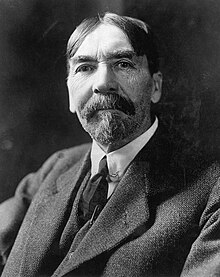Fine people theory
Fine people theory. An economic study of the institutions is a book by the American sociologist Thorstein Veblen , which was first published in 1899 with the English original title The Theory Of The Leisure Class. An Economic Study of the Evolution of Institutions appeared. The book contains an analysis of the prestige-generating function of consumption as well as a snappy criticism of the American upper classes at the turn of the century.
content
For Veblen, one of the central institutions is private property and the associated emergence of property and power and the resulting recognition ( prestige ). However, property only generates effective prestige gain when it is publicly displayed. This display is the focus of the book.
In contrast to European societies, prestige and social status in the USA at the end of the 19th century are not based on evolved birth-class conditions. Class differentiation is primarily generated by the current accumulation of property and prestige, with prestige initially arising solely from property. For the purpose of distinction , however, two mechanisms are required, "both of which are a civilized form of archaic muscle showing and puffing up": demonstrative idleness and demonstrative consumption .
Demonstrative idleness is defined by the greatest possible distance from productive gainful employment. What is decisive here is the apparent abolition of the reference to utility, idleness in this sense in no way means doing nothing. It is about unproductive activities , such as learning dead languages, acquiring sophisticated manners or the amateurish practice of art. Idleness from Veblen's point of view therefore produces nothing other than education and culture, which are converted into prestige through presentation. According to Veblen, however, this form of distinction is on the decline and is being replaced by demonstrative consumption . It goes far beyond what would be necessary to maintain life and psychic powers. The “idle gentleman” enjoys “the best of food, drinks, narcotics, houses, waiters, jewelry, clothing, weapons, amusements, amulets, idols and deities” freely and uninhibited. And because not for personal consumption If there is enough time, substitute consumption is also used: expensive gifts and celebrations for servants, wives, friends and guests, whereby the usefulness aspect remains ignored - waste creates prestige.
According to Veblen, the aesthetic norms of taste in society follow the same functional logic: One often finds beautiful things that are expensive and useless. This logic does not only apply to the upper strata of society, but is a general characteristic of the social world.
effect
While Talcott Parsons and Daniel Bell dismissed the social criticism contained in the book as unrealistic and utopian, David Riesman developed a complementary description of the demonstrative production . By this he meant the attempt by companies to increase their prestige with the help of representative buildings, exclusively trained employees and special social benefits. Robert K. Merton adopted Veblen's assumption of demonstrative consumption as an example of the latent functions of social action: People buy expensive goods not because of their material qualities, but because of their prices, because only these can raise the social status of the buyer. By the end of the twentieth century, Veblen's study fertilized lifestyle analyzes like that of Pierre Bourdieu ( The Subtle Differences ).
Expenses (selection)
- The theory of the leisure class. An economic study in the evolution of institutions . The Macmillan Company, New York / London 1899.
- The theory of the leisure class. An economic study of institutions . Reprint, The Macmillan Company, New York 1912.
- The theory of the leisure class , with an introduction by John Kenneth Galbraith . Houghton Mifflin, Boston 1973.
- The theory of the leisure class , with an introduction by C. Wright Mills , Transaction Publishers, New Brunswick 1992.
-
The theory of the leisure class . Edited and with an introduction by Martha Banta, Oxford University Press, Oxford / New York 2007.
- Fine people theory. An economic study of the institutions . Kiepenheuer & Witsch, Cologne / Berlin 1958 (translated by Suzanne Heintz and Peter von Haselberg).
- Fine people theory. An economic study of the institutions . Deutscher Taschenbuch-Verlag, Munich 1971 (translated by Suzanne Heintz and Peter von Haselberg), ISBN 978-3-423-00762-7 .
- Fine people theory. An economic study of the institutions . Fischer Taschenbuch-Verlag, Frankfurt am Main 2007 (translated by Suzanne Heintz and Peter von Haselberg), ISBN 978-3-596-17625-0 .
See also
Web links
- Upper classes. Feine Menschen , book review of the first German-language edition in: Der Spiegel , May 21, 1958.
- Susanne Wesch: About the tendency to waste Thorstein Bunde Veblen: "The theory of fine people" , book review in: Die Zeit , August 8, 1999.
- Lena Schipper: Thorstein Veblen. Mockery of the fine people , in: Frankfurter Allgemeine Zeitung , June 7, 2014.
Individual evidence
- ^ From a new edition in 1912 with a shortened title: The theory of the leisure class. An economic study of institutions .
- ↑ Information on the book and reception are based, unless otherwise documented, on: Ludgera Vogt : Thorstein Veblen. The Theory Of The Leisure Class . In: Dirk Kaesler , Ludgera Vogt (Hrsg.): Major works of sociology (= Kröner's pocket edition . Volume 396). Kröner, Stuttgart 2000, ISBN 3-520-39601-7 , pp. 435-439.
- ↑ Ludgera Vogt: Thorstein Veblen. The Theory Of The Leisure Class . In: Dirk Kaesler, Ludgera Vogt (Hrsg.): Major works of sociology . Kröner, Stuttgart 2000, pp. 435-439, here p. 436.
- ↑ Ludgera Vogt: Thorstein Veblen. The Theory Of The Leisure Class . In: Dirk Kaesler, Ludgera Vogt (Hrsg.): Major works of sociology . Kröner, Stuttgart 2000, pp. 435-439, here p. 437.
- ↑ Thorstein Veblen: Theory of the fine people. An economic study of the institutions . Deutscher Taschenbuch-Verlag, Munich 1971, p. 66.
